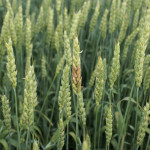Reading Time: 2 minutes Although it’s likely too late to apply a fungicide for fusarium graminearum, producers can still use the information they gather about the outbreak to plan for subsequent growing seasons. Fusarium graminearum is considered the most important fusarium head blight (FHB) species due to its aggressiveness and production of deoxynivalenol or DON (a.k.a. vomitoxin), said crop […] Read more

Now is the time to create next year’s battle plan for fusarium
Scouting this year is the first step in limiting the impact of the cereal disease next year

Prairie feed wheat, barley at seasonal highs
CNS Canada –– Feed barley and feed wheat appear to be settling into some seasonal highs, according to a market-watcher in Alberta. “Whether it goes up much more remains to be seen,” said Jim Beusekom of Market Place Commodities in Lethbridge. “Between Easter and May long weekend, we’re probably at a high.” High vomitoxin (10 […] Read more

Fusarium head blight infections hit record high in 2016
Almost one-quarter of cereal samples from 2016 have tested positive for fusarium head blight — a 10 per cent jump from 2014’s previous record high
Reading Time: 5 minutes Fusarium head blight continued its devastating march across Alberta last summer, and shows no sign of slowing down. “It’s become something that’s well established in the southern part of the province, and the situation is starting to change elsewhere in the province, especially central and northern Alberta,” said Kelly Turkington, a research scientist with Agriculture […] Read more

‘Mini-harvest’ likely to weigh on feed grains
CNS Canada –– Seasonal lows in the Western Canadian feed grain market may stick around longer than normal this year, as the industry awaits the abnormal spring harvest of those fields left to overwinter this year. “The seasonals are fairly consistent,” said Jim Beusekom of Market Place Commodities in Lethbridge, adding “we usually see the […] Read more

Low-quality feed being dumped on market
CNS Canada — Prices for feed barley and wheat don’t appear ready to spike anytime soon, as farmers across Western Canada continue to dump supplies containing high concentrations of vomitoxin and fusarium into feedlots. “Steady as it goes here is the tone,” said Allan Pirness of Market Place Commodities in Lethbridge. “We’re looking to clean […] Read more

Toxins could be present in ensiled corn
Reading Time: < 1 minute Watch for the presence of mycotoxins when feeding ensiled corn. When the toxins T-2, HT-2 and DON (vomitoxin) are present, cattle will reduce the amount of feed they eat, said provincial veterinary toxicologist Joe Kendall. “However, if you ensile the standing crop with the mycotoxins present, you are mixing good and contaminated feed together so […] Read more

StatsCan confirms drought impact on Ontario yield
Statistics Canada has confirmed what most farmers in Ontario knew this past summer: Hot and droughty conditions drove production of corn and soybeans almost 10 per cent lower than 2015 levels. StatsCan’s harvest report, released this week, also showed the large wheat crop in Ontario was a record, with a 56 per cent increase in […] Read more

Rising durum bids topping out in Western Canada
CNS Canada — Durum bids in Western Canada posted solid gains over the past two months, with concerns over the quality of the crop behind much of the strength. Prices are showing signs of topping out, though — and the highs may be in for now. Spot durum bids in southern Saskatchewan, where the bulk […] Read more

Quality Canadian durum may be in short supply
CNS Canada — Quality issues with the Canadian durum crop currently being harvested should see the price spreads between top- and low-end grain widen considerably, especially as the carryout from the previous year is also poor quality. Canadian durum stocks, as of July 31, were pegged at 1.1 million tonnes by Statistics Canada in a […] Read more

Don’t let down your guard when it comes to fusarium
Provincial crop specialist says seed testing and using seed treatment are critical
Reading Time: 2 minutes Fusarium head blight outbreaks can cause significant losses in grain yield and grain quality, while also resulting in the production of mycotoxin-Deoxynyvalenol that affects livestock feed, the baking and milling quality of wheat and the malting and brewing qualities of malt barley. That’s why producers need to be vigilant, even if its rate of infection […] Read more

